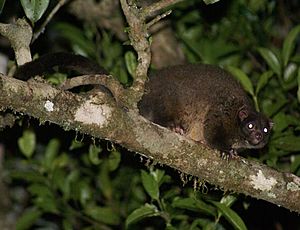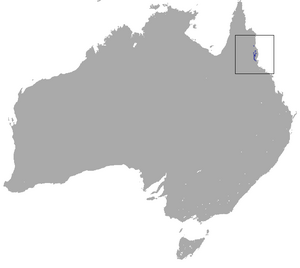Lemur-like ringtail possum facts for kids
Quick facts for kids Lemur-like ringtail possum |
|
|---|---|
 |
|
| In Queensland, Australia | |
| Conservation status | |
| Scientific classification | |
| Genus: |
Hemibelideus
|
| Species: |
lemuroides
|
 |
|
| Lemur-like ringtail possum range | |
The lemur-like ringtail possum (Hemibelideus lemuroides) is a very special type of ringtail possum. People sometimes call it the lemuroid ringtail possum or the brushy-tailed ringtail.
At first, scientists thought these possums were like gliding possums. In fact, their scientific name Hemibelideus means "half-glider." This is because they can leap very well, almost like they are gliding! They have a long tail that can grab things, which helps them live in trees. Their faces look a bit like lemurs, with short noses, big eyes that face forward, and small ears.
They have a bushier tail than other ringtail possums. You can tell them apart from the greater glider because they don't have a gliding membrane. Also, their ears are much shorter and don't have much hair. These possums like to live in groups.
Where They Live
This possum lives in a small area in Queensland, Australia. This area is between the towns of Ingham and Cairns. There's also a small group living on the Mount Carbine Tableland. Both of these places are part of the Wet Tropics World Heritage Area.
These possums live only in trees, high up in the tops of old forests. They prefer certain types of trees and usually live at high elevations, between 480 and 900 meters above sea level. They are about 30–38 centimeters long, and their tail is about 30–35 centimeters long. They weigh between 810 and 1140 grams.
Facing Challenges
Scientists have been studying these possums. A researcher named Stephen Williams from James Cook University noticed something worrying. After some very hot weather in 2005, very few of these possums were seen for several years. Slowly, their numbers started to increase again.
In 2018, another very hot period hit the Cairns area. Temperatures reached 39 °C, which was the highest ever recorded there. Many animals that live in tropical areas, like the lemur-like ringtail possum, cannot handle extreme heat. Their bodies are not made to cool down when it gets too hot. Temperatures above 29 degrees can be deadly for them.
Over the last 15 years, some animal species have started to disappear from lower areas. This forces them to live in smaller areas at higher elevations. For animals like the lemur-like possum, which live on mountain tops, there's nowhere else for them to go when it gets too hot. The nearest rainforest is very far away, about 1000 kilometers. This makes it harder for them to survive.
Images for kids
See also
 In Spanish: Falangero lemuroide para niños
In Spanish: Falangero lemuroide para niños




